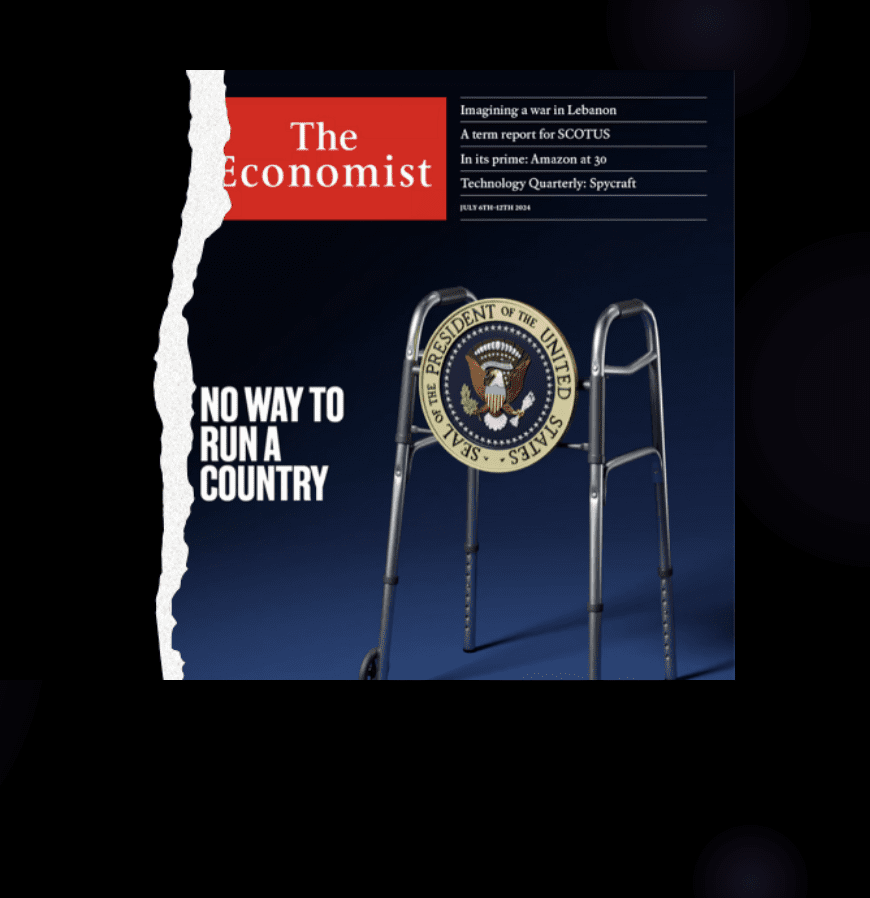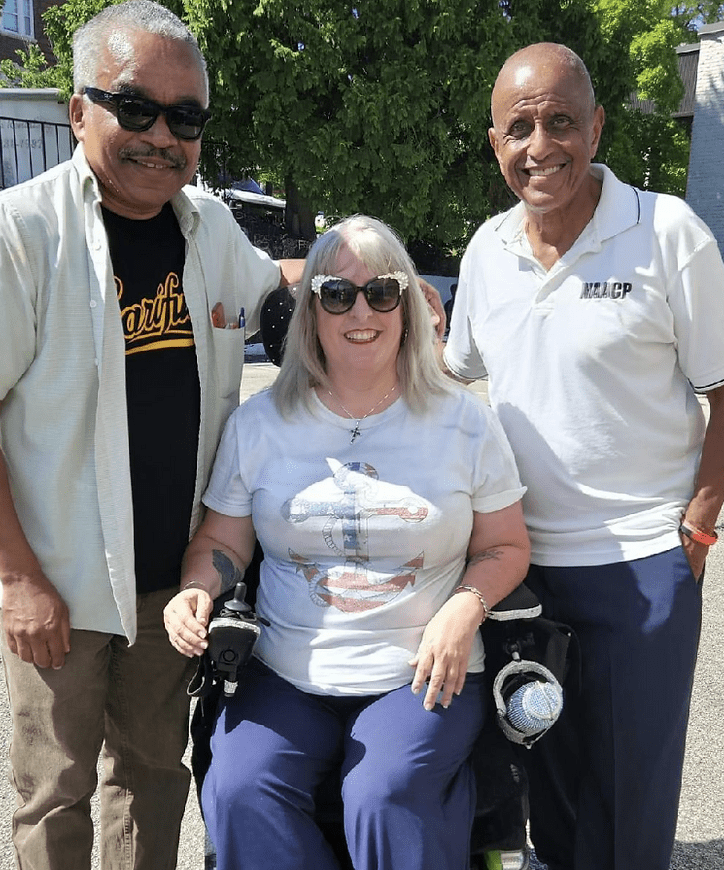Search Posts
Recent Posts
- RI Veterans: Did you know? 19.06.25 (Military Funerals, Job Fair, Benefits, Events) – John A. Cianci June 19, 2025
- East Providence First in U.S. to Equip All Firefighters with PFAS-free Gear June 19, 2025
- We Cook! Mill’s Tavern Saffron Bouillabaisse with Tarhana Lobster Jus June 19, 2025
- Rhode Island Weather for June 19, 2025 – Jack Donnelly June 19, 2025
- MAHA adopters prefer carrot to the stick: Kraft Heinz. General Mills. Walmart. Sam’s Club. Starbucks… June 19, 2025
Categories
Subscribe!
Thanks for subscribing! Please check your email for further instructions.

Cover design of The Economist weaponizes disability
Commentary
It’s not the physical issues – not the halting gait or the occasional slip and falls, or even tumbles. It’s not the falls up the stairs of Air Force One. It’s not the sprawl on the stage after stubbing his foot on a sandbag at that graduation.
It shouldn’t have anything to do with the President being accommodated by providing access to a shorter set of stairs on an airplane, or having aids walk with him, or changing shoes to a more secure, orthopedic type. Or having the First Lady help him on with his jacket or holding his hand to steady him.
It shouldn’t have anything to do with these things – yet it is all about these things – as President Biden’s fitness to serve and fitness to run for another 4-year term of office come into question.
What it should be all about is the president’s cognitive fitness – a measure we hear in his speech and mannerisms. And one calling out to be measured.
The Economist
The cover of The Economist did nothing to combat discrimination faced by so many people who have temporary or permanent physical differences. Designers of the cover could come up with nothing better – or more dramatic – than the seal of the President of the United States on the front of a walker, which they call “a Zimmer”, meaning a mobility walker. To those of us with history in the disability field, the cover startled. Accessibility devices are what makes living in the world for those with physical differences possible – they allow mobility or stability – whether in a wheelchair or walking with a cane or taking the stairs one at a time because of a hip injury, or walking with a limp.
The cover set back advances in perception about physical disabilities – they are only for the “infirm” or “old” or “incompetent” or with an “inability to serve”. Forget all you know about the famous or the familiar who succeed and contribute in spite of any physical difference.
Presidents we’ve known
Franklin Delano Roosevelt is often thought of as the only United States President with a disability, but our nation has a distinguished line of presidents with disabilities or other special needs.
William Jefferson Clinton, 1946 – (hearing impairment) – 42nd President of the United States (1992-2000); wears hearing aids.
John F. Kennedy, 1917-1963 (chronic back pain) – 35th President of the United States (1960-1963); would wear a back brace on his most painful days.
Ronald Reagan, 1911-2004 (hearing impairment) – 40th President of the United States (1980-1988). Would eventually announce early Alzheimer’s, going downhill rapidly, and dying a few years after his diagnosis.
Franklin Delano Roosevelt, 1882-1945 (polio) – 32nd President of the United States (1933-1945); used a wheelchair, which he and the media hid as best they could from the general public due to perception and discrimination.
Political leaders today
Governor Gregg Abbott, Governor of Texas, graduated from the University of Texas at Austin and earned a law degree from Vanderbilt University. Shortly after law school, at age 26, he was paralyzed below the waist by a falling tree while jogging after a storm. Two steel rods were implanted in his spine, and he underwent extensive rehabilitation and has used a wheelchair ever since. He has served as the 48th governor of Texas since 2015. Abbott uses a variety of wheelchairs, including one to help him navigate sand and uneven terrain when at the border with Mexico holding a press conference.
There are numerous members of Congress who struggle with physical disabilities. Perhaps the one who comes to mind right away is James Langevin, from Rhode Island, who served as our RI Representative for decades, a quadriplegic from being shot by accident as a young man. Langevin today runs the Cybersecurity program at Rhode Island College.
There also was Rep. Bob Dole, who lost the function of his arm in the war, and Sen. Tammy Duckworth, who lost both legs and damaged her right arm in the war, and serves to this day. More on those who serve or served with physical challenges: https://en.wikipedia.org/wiki/List_of_physically_disabled_politicians – it’s an exhaustive list.

R.A.M.P. (Real Access Motivates Progress) founder Tina Guenette, who is one of the most active professionals and advocates in Rhode Island was asked about the cover of The Economist, and commented, “I mean, look at everything that I do from a wheelchair – if I could do that why would it be a problem to do anything from the walker or a cane. There are so many disabled people that are doing amazing and great things in this world. Our disability doesn’t hold us back. It’s the inaccessibility of our surroundings that impede us.”
___

We also reached out to the RI Governor’s Commission on Disabilities. This statement was provided by Elisabeth Hubbard, Executive Secretary: “The image of a mobility aid is used in this context to weaponize disability. It implies that someone with a disability is not capable. The Economist’s editors admittedly used the walker claiming it to be a ‘universal symbol of failing power’. Their justification is flawed, as mobility aides are used to empower users. The wheelchair, for example, is the universal symbol of accessibility, representing the modification of environments so that people with disabilities can participate equally in society. The Economist’s choice of imagery demonstrates a lack of understanding of disability, not to mention imagination.”
___
The Economist responds
The magazine also wrote an article – well hidden, as was the lede article that went with the walker – behind a paywall. The article tried to explain their use of the symbol of the walker, calling it “a Zimmer, the universal symbol of failing powers”, while never acknowledging any uproar at its use.
Here is a portion of their statement:
“Mr. Biden deserves to be remembered for his accomplishments and his decency rather than his decline. But there is no getting away from the fact that his mental and physical competence have become central to this race. Our task was to represent that without being crass or cruel.
In our first idea, showing false teeth in a glass on the presidential lectern, was not only off-putting, but also strayed into Monty Python territory.
A recliner in the Oval was better—because it contrasted the fitness of man with the demands of his position. Mr. Biden can still appear dynamic during short, scripted appearances. But you cannot run a superpower by autocue. And you cannot put an international crisis on hold because the president is having a bad night.
A melancholy drawing of a man with a Zimmer frame looking out through the White House windows pointed to a different set of risks. As the head of state, America’s president embodies the virtues of the republic. The more he is seen as a stubborn old man who leaves the real work to his courtiers, the more he will undermine Americans’ faith in their system of government.
If he did the honourable thing this weekend, and withdrew from the race, our cover would rightly seem to be a cruel misjudgment of the man and his character.
That is why we settled on a cover based on the Zimmer and the presidential seal. One version we considered did not work as Mr Biden was clearly not the man behind the Zimmer. By taking him away, however, we could both focus on the presidency and also have a cover that would make sense if the president pulled out of the race.
That left the question of taste. Some may feel that this cover pokes fun at the physically infirm. Yet the Zimmer frame is a universal symbol of failing powers even if, obviously, you can struggle to walk without struggling to think. You only have to be aware of the context to know that we are not saying that physically disabled people should be barred from serving as president.
Others may feel that criticising Mr Biden is simply too harsh. But harshness is justified here.”
___
The Economist needs to do better – and they need to make it up to those with physical differences. Designers need to do better. Editors and broadcasters need to think again about poking fun at falls, trips, etc. We all need to be kinder in our thought and to realize the ADA issues we see all around us at work and in life are there to help equalize what can be a cruel world to those who are injured, or living with lifelong (dis)ability. Raising awareness about this issue can best succeed if one tries to “walk a mile in their shoes” – so to speak.
For those who are hesitant to use a cane, or start with leaning on a shopping cart, or a tall umbrella, or another mobility assist – more functional shoes, etc. – we ask why – and often the answer is public perception – job insecurity – discrimination. We’ve come far on a global perspective, and with laws such as ADA – but on a personal basis, there is much progress to be made. It takes strength to lead.
For that matter, President Biden could start using a cane. Why not? Just think how that would help with awareness and acceptance for physical differences.
We wish Stephen Hawking were here. What would he say? How about what he did say – “We have a moral duty to remove the barriers to participation, and to invest sufficient funding and expertise to unlock the vast potential of people with disabilities,” wrote Hawking, in a foreword to the World Report on Disability.
We invite your comments, below…
